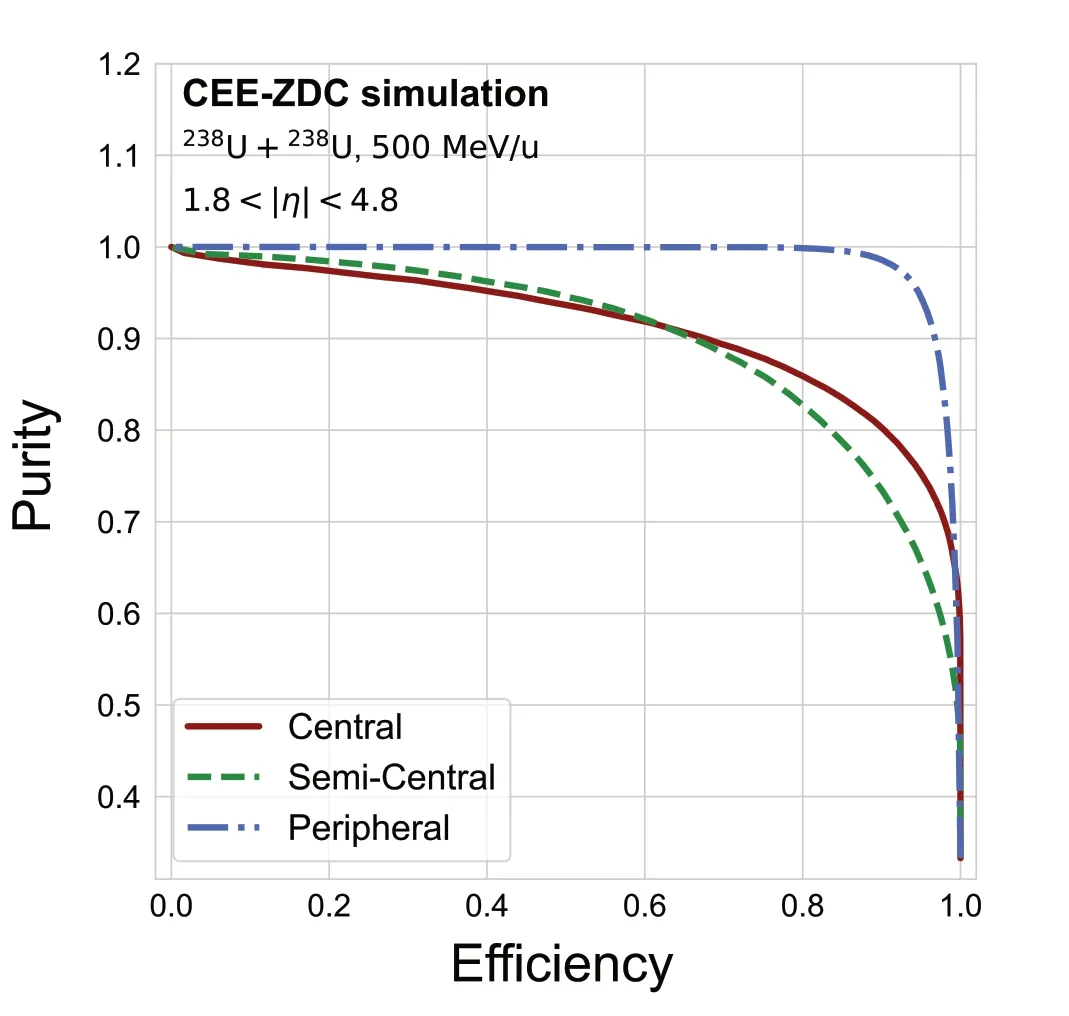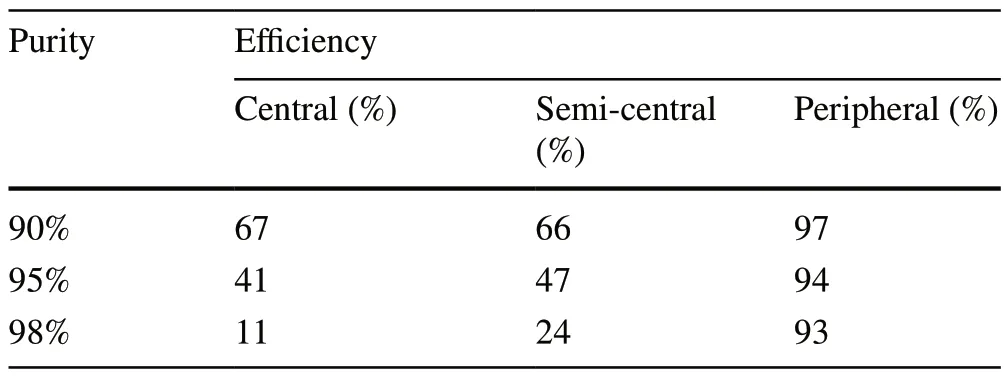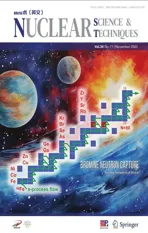Classifier for centrality determination with zero-degree calorimeter at the cooling-storage-ring external-target experiment
2024-01-15BiaoZhangLiKeLiuHuaPeiShuSuShiNuXuYaPingWang
Biao Zhang · Li-Ke Liu · Hua Pei · Shu-Su Shi · Nu Xu · Ya-Ping Wang
Abstract The zero-degree calorimeter (ZDC) plays a crucial role toward determining the centrality in the Cooling-Storage-Ring External-target Experiment (CEE) at the Heavy Ion Research Facility in Lanzhou.A boosted decision tree (BDT) multiclassification algorithm was employed to classify the centrality of the collision events based on the raw features from ZDC such as the number of fired channels and deposited energy.The data from simulated 238U + 238U collisions at 500 MeV∕u ,generated by the IQMD event generator and subsequently modeled using the GEANT4 package, were employed to train and test the BDT model.The results showed the high accuracy of the multi-classification model adopted in ZDC for centrality determination, which is robust against variations in different factors of detector geometry and response.This study demonstrates the good performance of CEE-ZDC in determining the centrality in nucleus—nucleus collisions.
Keywords ZDC · Boosted decision trees · Multi-classification · IQMD · Centrality determination
1 Introduction
The primary objective of conducting heavy-ion collisions at different beam energies is to investigate strong interaction matter and understand the QCD phase diagram.The phase diagram provides information on the phase transition and critical point of a strongly interacting system, where hadron gases exist at lower temperatures and low baryon densities;at higher temperatures or densities, the hadronic boundary disappears, and confined quarks move freely throughout the system [1].The Beam Energy Scan program of RHICSTAR aims to approach the possible critical point from the high-energy side.However, it is essential to study the phase diagram of the hadron phase and approach the critical point from the low-energy side [2—4].The Cooling-Storage-Ring External-target Experiment (CEE) at the Heavy Ion Research Facility in Lanzhou (HIRFL), with its advanced spectrometer, provides significant opportunities for studying phase diagrams at extremely high net baryon density levels with energies of several hundred AMeV [5].
The zero-degree calorimeter (ZDC), one of the subdetectors of CEE in the forward rapidity region, is designed to accurately determine the centrality and reaction plane of collision events [6].Collision events are typically classified into centrality classes representing certain fractions of the total reaction cross section corresponding to specific intervals of the impact parameterb[7].The impact parameterbis essential for understanding the initial overlap region of the colliding nuclei in heavy-ion collisions; it represents the distance between the nuclei centers in the plane transverse to the beam axis and determines the size and shape of the resulting medium.However, the impact parameterbis not directly measurable in the experiments.To estimate centrality experimentally, raw observables that scale monotonically with impact parameter can be used for classification according to centrality, for example, the reconstructed tracks with central barrel tracking detectors or the deposited energy in the forward calorimeters.Accurate centrality determination is a baseline for many physical analyses in heavy-ion collision experiments [8], particularly when searching for observables sensitive to a possible phase transition or critical point through analysis of fluctuations and correlations.
In recent years, Machine Learning (ML) methods have gained significant attention for determining the centrality of heavy ion collisions [8, 9].Previous studies treated centrality determination as a regression problem on impact parameters and utilized combined information from central tracking systems and forward calorimeters to train ML models.However, to avoid autocorrelation in the physics analysis, this study adopts a machine learning approach that utilizes raw experimental features from a forward calorimeter to determine centrality.We report the application of a multi-classification ML algorithm based on Boosted Decision Trees (BDT) as a centrality classifier using only ZDC in238U +238U collisions at 500 MeV∕u at the CEE.The ML inputs were generated using the Isospin dependent Quantum Molecular Dynamics (IQMD) generator [10].In addition,we present the efficiency and purity measures related to the centrality determination performance of the ZDC with a model application.
2 CEE-ZDC
The CEE, which utilizes fixed-target-mode heavy-ion collisions, is the first large-scale experimental nuclear device operating in the GeV energy region in China.It is equipped with a set of sub-detectors, as shown in Fig.1a.The detector system comprises a beam monitor, T0 detector [5], time projection chamber (TPC) [11], inner time-of-flight (iTOF)detector [12], large superconducting dipole magnet, multiwire drift chamber (MWDC) [13], external time-of-flight(eTOF) detector [14], and zero-degree calorimeter (ZDC)[6].
The purpose of the ZDC is to detect particle fragments in the forward rapidity region following semi-central and peripheral collisions, which provides vital information for the precise reconstruction of the centrality and reaction plane of collision events [6, 15].The ZDC is centrally positioned at the end of the CEE, covering a pseudorapidity range of 1.8<η<4.8.The ZDC utilizes a symmetrical and fan-shaped layout with eight radial and 24 angular sections and a maximum radius of 1 m.The detector comprises trapezoidal modules equipped with uniform plastic scintillators that are coupled with a light guide and connected to photomultiplier tubes (PMT) to convert scintillation light into charge signals.To obtain a comprehensive signal, each module provides two charge signals from the two dynodes of each PMT that are transmitted to two separate readout channels, resulting in 384 (24 × 8 × 2) channels for the ZDC.
3 Model training with simulated event
The simulated data were generated by simulating238U +238U collisions at 500 MeV/u using an IQMD generator [10].The generated particles were then transported through the apparatus using the GEANT4 package [16].Determining the centrality with only one forward rapidity detector, such as ZDC, is challenging even when employing ML algorithms.Previous ML-based studies on centrality determination relied on information from multiple subsystems within the detector, such as tracks reconstructed from central barrel detectors and deposited energy in forward calorimeters,revealing a strong correlation between the centrality class and observables.CEE-ZDC is a nontracking detector, and the number of spectator nucleons in a nucleus—nucleus collision is expected to be proportional to the deposited energy and number of fired channels in the ZDC.However, the presence of a beam hole at the center of ZDC and the limiteddetector acceptance result in a weak monotonic dependence between the impact parameters and observables, as illustrated in Fig.2a, which shows the number of fired channels and Fig.2b, which shows the energy deposited in ZDC.

Fig.1 (Color online) a CEE detector schematic layout.b ZDC detector layout

Fig.2 (Color online) a The number of fired channels in ZDC as a function of impact parameter.b The deposited energy in ZDC as a function of impact parameter
Potential improvements in centrality determination can be achieved by utilizing data from ZDC-subrings in conjunction with the ZDC as an additional feature in the ML task.Moreover, it may be advantageous to use the energy deposited in the ZDC ring-by-ring and the number of event-byevent fired channels and to exploit all inherent correlations between modules.Figure 3a displays the probability distribution of the fired ZDC channels in the impact parameter range 7 Boosted Decision Trees (BDT), a family of popular supervised learning algorithms for classification and regression problems, are extensively used to analyze datain high-energy physics experiments.In this study, extreme gradient boosting (XGBoost), a powerful BDTs based on the gradient boosting method, was adopted to solve multiclassification problems for centrality determination.The physical features used as the inputs for model training are the deposited energy in the full ZDC and ZDC substrings as well as the number of fired channels in ZDC.The simulated data were divided into three centrality classes based on the impact parameters listed in Table 1.The samples were divided into training and test samples of equal size for each centrality class.A state-of-the-art machine learning hyperparameter optimization with Optuna was adopted to speed up optimization time and achieve the best performance of the training models [17]. Table 1 The centrality classes with respect to the impact parameter b intervals Fig.4 (Color online) The probability distributions of belonging to the central class (a) and peripheral class b for both the training and test sets The machine learning model was applied to both the training and test sets to visualize the distributions of the ML output scores and to check for consistency between the two sets.For classification with three centrality classes (pi), the model generates three scores representing the probability of belonging to each class considered.According to construction, the probabilities for the centrality classes sum to one (∑3i=1pi=1 ).Figure 4 illustrates the probability distributions of the central (a) and peripheral classes (b) for both the training and test sets.The probability distributions were close to unity for each probability distribution corresponding to the respective true class, whereas the other two distributions shifted toward zero.The probability density functions of the training and test samples for each centrality class agreed well, indicating that the model did not overfit. Fig.5 (Color online) ROC curves and AUCs with respect to different“One-vs-One” cases are shown with the different line colors The Receiver Operating Characteristic (ROC) curve is commonly used to evaluate the performance of a classification model by plotting the true-positive rate against the false-positive rate for various threshold settings.The area under the ROC curve, known as ROC AUC, provides a global measure of the model performance, ranging from 0.5 (random classification) to 1 (perfect classification), independent of the threshold and class distribution [18].However, for multi-class classification, the ROC curve cannot be directly defined, and the “One-vs-One” approach is used to compute the overall average of the individual ROC AUCs for each pair of classes.The ROC curves and ROC AUC values obtained for the test set are shown in Fig.5.The high final ROC AUC value of approximately 0.96 indicates that the BDT model is highly effective in determining centrality. Fig.6 (Color online) Efficiency versus purity of the multi-classification models for each centrality class.The red, green, and blue lines represent the central, semi-central, and peripheral classes, respectively Table 2 Efficiency and purity values for different centrality classes The performance of the centrality classification model was evaluated by calculating its efficiency and purity based on ML output scores.Efficiency refers to the fraction of correctly classified events, whereas purity measures the fraction of events correctly classified for a particular centrality class out of all the events assigned to that class.The efficiency versus purity of the multi-classification models for each centrality class is shown in Fig.6, where the red, green,and blue solid lines represent the central, semi-central, and peripheral classes, respectively.The peripheral class was the most effectively classified, and the central class was more challenging than the semi-central class in higher-efficiency regions.The values listed in Table 2 indicate that even at very high purity levels, the efficiency of the peripheral class is not significantly compromised, and both the central and semi-central classes exhibit promising efficiency values at high purity.These results indicate that the ML-based event centrality determination utilized in ZDC is effective. In addition, to evaluate the performance of the centrality determination with ZDC, the effects of several factors related to the configuration of ZDC in the simulation data were systematically investigated.These factors include the thickness of the plastic scintillator of ZDC detector, hit effi-ciency, energy resolution, and heavy nuclei with or without de-excitation (tunable settings in IQMD).The ZDC plastic scintillator thickness was varied from 1 to 4 cm, and the hit efficiency was varied from 90% to 95%.The deposited energy was also smeared with different sigma values of Gaussian distributions.As illustrated in Fig.7, the red,green, and blue lines indicate central, semi-central, and peripheral collisions, respectively.Changes in these factors are depicted by distinct line styles.The results indicated that the effects of these factors on the purity and efficiency of the centrality classification were minor.Among the tested factors, the ZDC detector thickness had the most significantimpact, although its effect was relatively small.In conclusion, this study suggests that the multi-classification adopted in ZDC is robust against variations in these factors, indicating the potential for reliable and accurate classification of centrality using ZDC. Fig.7 (Color online) The effects of several factors on the efficiency and purity for the multi-classification models: a thickness of ZDC detector, b hit efficiency in ZDC (b), c energy resolution, d with or without de-excitation.The red, green,and blue colors of the lines represent central, semi-central,and peripheral collisions,respectively.The variation of the factors is shown with the different line styles This study aimed to determine the centrality class of nucleus—nucleus collisions at the CEE-ZDC detector using a multi-classification model based on the XGBoost classifier.The ML model was trained and tested using simulation data from the IQMD event generator, and then modeled using the GEANT4 package.An additional study examined various factors associated with the geometry and response of the ZDC detector.The results indicated that the impact of these factors was minor, demonstrating the robustness of the XGBoost classifier in determining centrality.Future work may include improving the accuracy of centrality determination by incorporating regression tasks and exploring other machine learning algorithms.This study indicates the good performance of CEE-ZDC for centrality determination in nucleus—nucleus collisions. Acknowledgements We thank Prof.Li Ou and Zhi-Gang Xiao for generating IQMD data and for fruitful discussions. Author Contributions All authors contributed to the study conception and design.Material preparation, data collection and analysis were performed by Biao Zhang, Hua Pei, Li-Ke Liu, Ya-Ping Wang, Shu-Su Shi, and Nu Xu.The first draft of the manuscript was written by Biao Zhang and all authors commented on previous versions of the manuscript.All authors read and approved the final manuscript. Data availability The data that support the findings of this study are openly available in Science Data Bank at https:// www.doi.org/ 10.57760/ scien cedb.j00186.00294 and https:// cstr.cn/ 31253.11.scien cedb.j00186.00294. Declarations Conflicts of interest The authors declare that they have no competing interests.

4 Performance of the ML models



5 Efficiency and purity of the centrality classification

6 Summary
杂志排行
Nuclear Science and Techniques的其它文章
- Effective extraction of photoneutron cross-section distribution using gamma activation and reaction yield ratio method
- Gravitational wave echoes from strange quark stars in the equation of state with density-dependent quark masses
- Pseudo-rapidity distributions of charged particles in asymmetric collisions using Tsallis thermodynamics
- Pairing effects on the fragment mass distribution of Th, U, Pu, and Cm isotopes
- Dynamic evaluation of a scaled-down heat pipe-cooled system during start-up/shut-down processes using a hardware-in-the-loop test approach
- A method for correcting characteristic X-ray net peak count from drifted shadow peak
